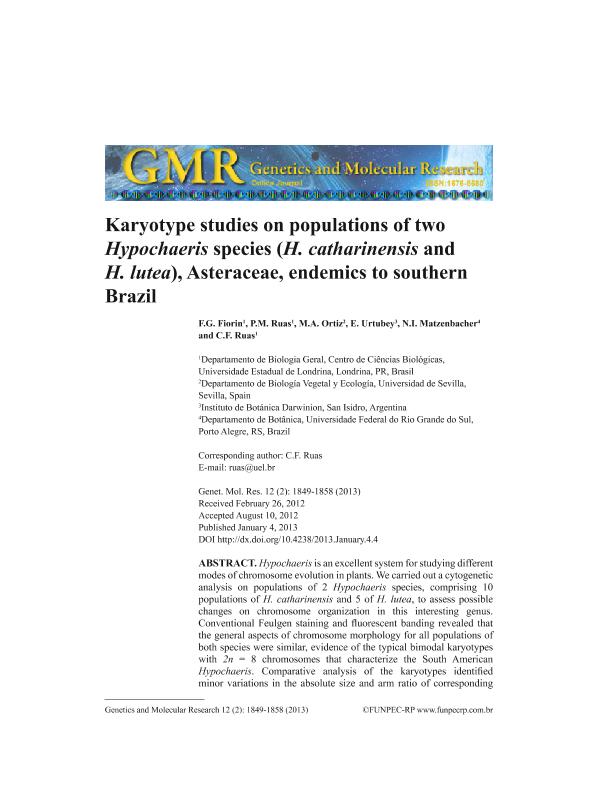Mostrar el registro sencillo del ítem
dc.contributor.author
Fiorin, F. G.
dc.contributor.author
Ruas, P. M.
dc.contributor.author
Ortiz, M. A.
dc.contributor.author
Urtubey, Estrella

dc.contributor.author
Matzenbacher, N. I.
dc.contributor.author
Ruas, C. F.
dc.date.available
2017-01-17T15:29:23Z
dc.date.issued
2013-01
dc.identifier.citation
Fiorin, F. G.; Ruas, P. M.; Ortiz, M. A.; Urtubey, Estrella; Matzenbacher, N. I.; et al.; Karyotype studies on populations of two Hypochaeris species (H. catharinensis and H. lutea), Asteraceae, from southern Brazil; Sociedade Brasileira de Genética; Genetics And Molecular Biology; 12; 2; 1-2013; 1849-1858
dc.identifier.issn
1415-4757
dc.identifier.uri
http://hdl.handle.net/11336/11463
dc.description.abstract
Hypochaeris is an excellent system for studying different modes of chromosome evolution in plants. We carried out a cytogenetic analysis on populations of 2 Hypochaeris species, comprising 10 populations of H. catharinensis and 5 of H. lutea, to assess possible changes on chromosome organization in this interesting genus. Conventional Feulgen staining and fluorescent banding revealed that the general aspects of chromosome morphology for all populations of both species were similar, evidence of the typical bimodal karyotypes with 2n = 8 chromosomes that characterize the South American Hypochaeris. Comparative analysis of the karyotypes identified minor variations in the absolute size and arm ratio of corresponding chromosome pairs. One population of H. lutea was entirely polyploid adding a novel cytotype to this species. Fluorescent banding revealed strong chromomycin A3 (CMA3)-positive signals on both arms of chromosomes 3 and 4 of H. catharinensis, revealing a new pattern for the distribution of GC-rich heterochromatin in Hypochaeris. A strong CMA-positive signal was observed on the short arm of chromosome 3 in one population of H. lutea, while the other populations validated the CMA3 pattern already described for this species. While the overall karyotype similarities of the 2 species are in compass with all South American Hypochaeris, the presence of unusual large blocks of GC-rich heterochromatin suggests that chromosome rearrangements, related to dispersion of heterochromatin, are taking place in the karyotype of H. catharinensis. The novel polyploid cytotype identified in H. lutea provides support that polyploidization is an active process in the mode of chromosome evolution in Hypochaeris.
dc.format
application/pdf
dc.language.iso
eng
dc.publisher
Sociedade Brasileira de Genética

dc.rights
info:eu-repo/semantics/openAccess
dc.rights.uri
https://creativecommons.org/licenses/by-nc-sa/2.5/ar/
dc.subject
Hypochaeris
dc.subject
Karyotype
dc.subject
Populations
dc.subject
Brazil
dc.subject.classification
Ciencias de las Plantas, Botánica

dc.subject.classification
Ciencias Biológicas

dc.subject.classification
CIENCIAS NATURALES Y EXACTAS

dc.title
Karyotype studies on populations of two Hypochaeris species (H. catharinensis and H. lutea), Asteraceae, from southern Brazil
dc.type
info:eu-repo/semantics/article
dc.type
info:ar-repo/semantics/artículo
dc.type
info:eu-repo/semantics/publishedVersion
dc.date.updated
2016-11-24T17:22:38Z
dc.identifier.eissn
1678-4685
dc.journal.volume
12
dc.journal.number
2
dc.journal.pagination
1849-1858
dc.journal.pais
Brasil

dc.description.fil
Fil: Fiorin, F. G.. Universidade Estadual de Londrina; Brasil
dc.description.fil
Fil: Ruas, P. M.. Universidade Estadual de Londrina; Brasil
dc.description.fil
Fil: Ortiz, M. A.. Universidad de Sevilla; España
dc.description.fil
Fil: Urtubey, Estrella. Consejo Nacional de Investigaciones Científicas y Técnicas. Instituto de Botánica Darwinion; Argentina
dc.description.fil
Fil: Matzenbacher, N. I.. Universidade Federal do Rio Grande do Sul; Brasil
dc.description.fil
Fil: Ruas, C. F.. Universidade Estadual de Londrina; Brasil
dc.journal.title
Genetics And Molecular Biology

dc.relation.alternativeid
info:eu-repo/semantics/altIdentifier/url/http://www.geneticsmr.com/articles/1999
dc.relation.alternativeid
info:eu-repo/semantics/altIdentifier/doi/https://doi.org/10.4238/2013.January.4.4
Archivos asociados
